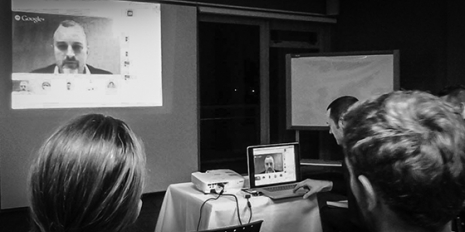
Imagine a world without Google search. It's almost a basic human right to be able to Google these days. Well the data giants aren't all Adwords and fancy glasses - Google.org is the non-profit arm that applies 1% of Google resource and profit to social impact and solving global issues with technology.
Craig Nevill-Manning, a Kiwi, is the Engineering Director for Google.org in New York and he was on the other end of a Google Hang-Out discussing some of the org projects with audiences dotted around New Zealand. Projects often come from Google employees’ side projects allowed under the 20% time rule where 1 day a week is allocated to self-initiated projects.
Here are a few examples of impact:
Within 48 hours after the 2010 Haiti quake a 20% project called Person Finder was deployed mainstream to reconnect missing people. The Haitian native language Creole was added to Google Translate to facilitate cross-language aid efforts.
The Google Maps cartography tool Mapmaker was rolled out to the public to chart the devastated Haiti capital of Port Au Prince. First responders were able to access the software and digitally chart the previously unmapped city. This took into account the new semi-permanent refugee camps and access points to get aid in quicker.
This work led to a specific Crisis Response team to be built inside Google.org that provided digital services in the aftermath of the February 2011 Canterbury quake and the Japanese tsunami a month later.
Mapping flu related search terms can accurately predict flu events and led Google to develop the Flu Trends tool. When aggregated data of flu searches is compiled with healthcare data the tool predicts flu events and scale of outbreak – early detection saves lives. The work has been scientifically published in Nature and a dengue fever equivalent is now live.
Craig was back in New Zealand for the first flight of Google's ambitious Project Loon, which is aiming to connect people to the internet in rural and remote areas and bring people back online after disasters. 12-metre-high balloons are flown 20 km above the Earth's surface, carrying network infrastructure. Loon was spawned inside Google's skunkworks lab Project X, also responsible for Google Glass and the self driving car.
The unfortunate irony of the webcast was that the lacklustre bandwidth struggled to keep up with the web cast (where was the Loon balloon now?). It was not necessarily Google's fault but more the telecoms provider – but that's why Google are now cutting out the middle man with their own service provider infrastructure.
The event was organised by the Start-Up Weekend initiative. Get your ticket for Tauranga's Start-Up Weekend here: http://swtauranga2013.eventbrite.com/
Comments
Post new comment